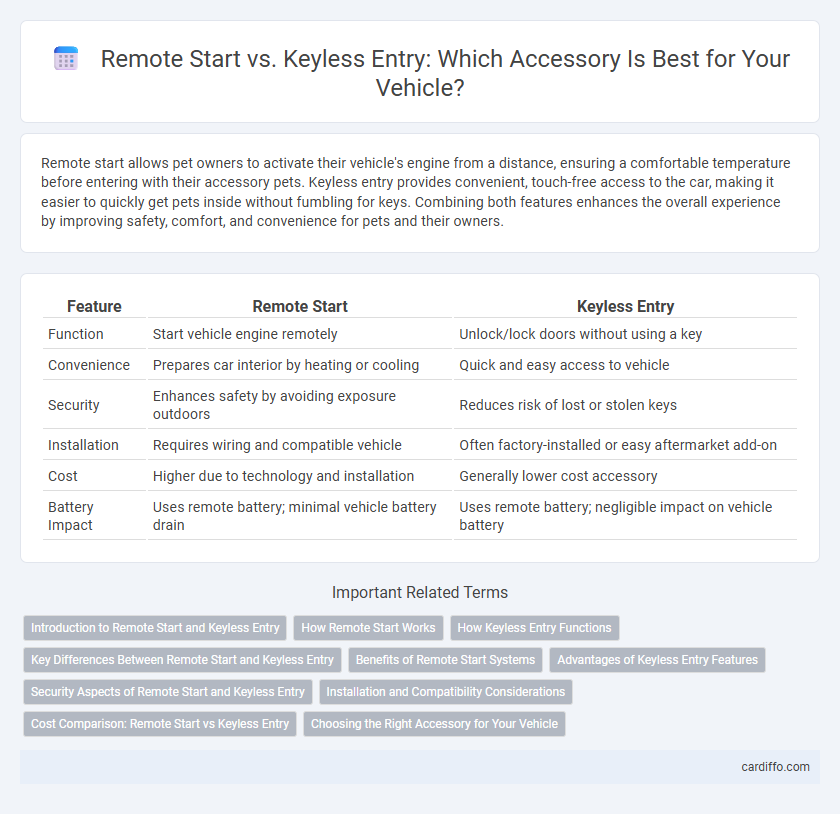Remote start allows pet owners to activate their vehicle's engine from a distance, ensuring a comfortable temperature before entering with their accessory pets. Keyless entry provides convenient, touch-free access to the car, making it easier to quickly get pets inside without fumbling for keys. Combining both features enhances the overall experience by improving safety, comfort, and convenience for pets and their owners.
Table of Comparison
| Feature | Remote Start | Keyless Entry |
|---|---|---|
| Function | Start vehicle engine remotely | Unlock/lock doors without using a key |
| Convenience | Prepares car interior by heating or cooling | Quick and easy access to vehicle |
| Security | Enhances safety by avoiding exposure outdoors | Reduces risk of lost or stolen keys |
| Installation | Requires wiring and compatible vehicle | Often factory-installed or easy aftermarket add-on |
| Cost | Higher due to technology and installation | Generally lower cost accessory |
| Battery Impact | Uses remote battery; minimal vehicle battery drain | Uses remote battery; negligible impact on vehicle battery |
Introduction to Remote Start and Keyless Entry
Remote start systems enable vehicle owners to start their engines remotely, providing convenience and climate control before entering the car. Keyless entry offers secure, key-free door access using a fob or smartphone, enhancing ease of use and security. Both accessories improve vehicle accessibility with advanced electronic controls and wireless communication technologies.
How Remote Start Works
Remote start systems use a wireless transmitter to send a coded signal to the vehicle's onboard receiver, activating the engine without the key present. This technology allows drivers to start their car remotely via a key fob or smartphone app, enabling climate control adjustment before entering the vehicle. The system integrates with the vehicle's security features to prevent unauthorized use, ensuring safety while enhancing convenience.
How Keyless Entry Functions
Keyless entry functions through a wireless key fob that communicates with the vehicle's onboard computer to lock or unlock doors without inserting a physical key. It uses radio frequency identification (RFID) or Bluetooth technology to verify the user's proximity and grant access automatically or via a button press on the fob. This system enhances convenience and security by allowing seamless entry while preventing unauthorized access.
Key Differences Between Remote Start and Keyless Entry
Remote start systems enable vehicle ignition from a distance, allowing the engine to warm up or cool down before entry, while keyless entry provides secure, proximity-based locking and unlocking of doors without using a physical key. Remote start primarily focuses on convenience and climate control, whereas keyless entry enhances security and accessibility. The technologies differ in functionality, with remote start requiring engine activation and keyless entry relying on wireless communication for door access.
Benefits of Remote Start Systems
Remote start systems enable vehicle owners to start their engines from a distance, providing immediate climate control by pre-heating or cooling the cabin before entering. This feature enhances comfort and convenience, especially in extreme weather conditions, while also improving safety by allowing the driver to ensure the vehicle is operational and secure before use. Remote start technology often integrates with smartphone apps, offering real-time vehicle status updates and remote control functions for optimized user experience.
Advantages of Keyless Entry Features
Keyless entry offers enhanced convenience by allowing vehicle access without physically using a key, providing quick and secure unlocking through proximity sensors or smartphone integration. Advanced security features, such as encrypted communication and automatic locking, reduce the risk of theft compared to traditional remote start systems. This technology supports seamless entry in various weather conditions and improves user experience by enabling personalized settings upon unlocking.
Security Aspects of Remote Start and Keyless Entry
Remote start systems enhance vehicle security by allowing engine activation from a distance, reducing the risk of theft through quick entry or hot-wiring. Keyless entry incorporates encrypted signals and rolling codes, minimizing the chances of relay attacks and unauthorized access. Both technologies rely on advanced encryption protocols to safeguard against hacking, yet keyless entry demands additional caution due to vulnerabilities like signal amplification.
Installation and Compatibility Considerations
Remote start systems often require professional installation due to the complexity of wiring integration with a vehicle's ignition and security system, ensuring compatibility with specific car makes and models. Keyless entry kits typically feature simpler installation processes, with compatibility mainly dependent on the vehicle's existing lock and security setup. Selecting the appropriate accessory necessitates verifying both installation requirements and compatibility to avoid functionality issues or security risks.
Cost Comparison: Remote Start vs Keyless Entry
Remote start systems typically range from $200 to $400, including installation, while keyless entry systems usually cost between $150 and $300. The higher price of remote start reflects the complexity of integrating engine control and safety features. Keyless entry offers basic convenience at a lower cost, making it a budget-friendly option for vehicle security and access.
Choosing the Right Accessory for Your Vehicle
Remote start systems enhance convenience by allowing you to start your vehicle from a distance, ideal for pre-warming or cooling. Keyless entry offers secure, quick access without fumbling for keys, improving daily usability. Selecting between these accessories depends on your lifestyle needs and vehicle compatibility to maximize comfort and security.
Remote Start vs Keyless Entry Infographic

 cardiffo.com
cardiffo.com